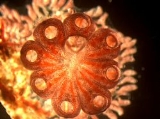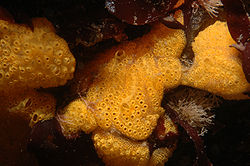
Botrylloides
Encyclopedia
The "Chain Sea Squirts or Chain Tunicates" of the genus Botrylloides:
Like Botryllus, Botrylloides are flat sheets of organisms which can be found covering ropes, boat hulls, horseshoe crabs, seaweeds, and any still or slow-moving object in saltwater. Also both are relative invasive Ascidians, found in many ports around the world. Invasive tunicates such as these, Didemnum
sp., and Styela clava
are a problem for shellfish
and other marine life populations, and cause fouling
of boats and piers.

Morphologically similar to Botryllus schlosseriBotryllus schlosseriBotryllus schlosseri, commonly known as the star ascidian or golden star tunicate, is an invasive, colonial ascidian tunicate that grows on slow-moving, submerged objects, plants, and animals in nearshore saltwater environments....
and similarly widespread, Botrylloides is distinguished by having linearly-arranged, parallel "chains" of zooids as opposed to zooids like white or yellow stripes emanating from a common center in Botrylloides.
Like Botryllus, Botrylloides are flat sheets of organisms which can be found covering ropes, boat hulls, horseshoe crabs, seaweeds, and any still or slow-moving object in saltwater. Also both are relative invasive Ascidians, found in many ports around the world. Invasive tunicates such as these, Didemnum
Didemnum
Didemnum is a genus of tunicates in the family Didemnidae. Some species of Didemnum can be characterized as invasive species. This is particularly an issue off the east coast of the United States, where in early 2006, Didemnum were estimated to inhabit more than 175 square kilometers of this...
sp., and Styela clava
Styela clava
The Stalked Sea Squirt, Styela clava, is a solitary, hermaphroditic, ascidian tunicate that is found off Australia and New Zealand, both coasts of North America, and Europe....
are a problem for shellfish
Shellfish
Shellfish is a culinary and fisheries term for exoskeleton-bearing aquatic invertebrates used as food, including various species of molluscs, crustaceans, and echinoderms. Although most kinds of shellfish are harvested from saltwater environments, some kinds are found only in freshwater...
and other marine life populations, and cause fouling
Fouling
Fouling refers to the accumulation of unwanted material on solid surfaces, most often in an aquatic environment. The fouling material can consist of either living organisms or a non-living substance...
of boats and piers.
Species include
- Botrylloides digense
- Botrylloides leachiBotrylloides leachiBotrylloides leachi is a colonial tunicate of the genus Botrylloides. Its unique methods of propagation and regeneration make it an ideal model organism for use in biological study of development, immunology, stem cells, and regeneration....
- Botrylloides simodensis
- Botrylloides violaceusBotrylloides violaceusBotrylloides violaceus is a colonial tunicate of the genus Botrylloides. Its native range is the in Northwest Pacific from Southern China to Japan and Siberia.. Colonies attach and grow on solid surfaces and substrates, and consist of individuals arranged in twisting rows...

External links
- http://ip30.eti.uva.nl/bis/tunicata.php?menuentry=soorten&id=20
- http://www.exoticsguide.org/species_pages/b_violaceus.html
- For a complete registry of Botrylloides taxa http://www.marinespecies.org/aphia.php?p=taxdetails&id=103528

